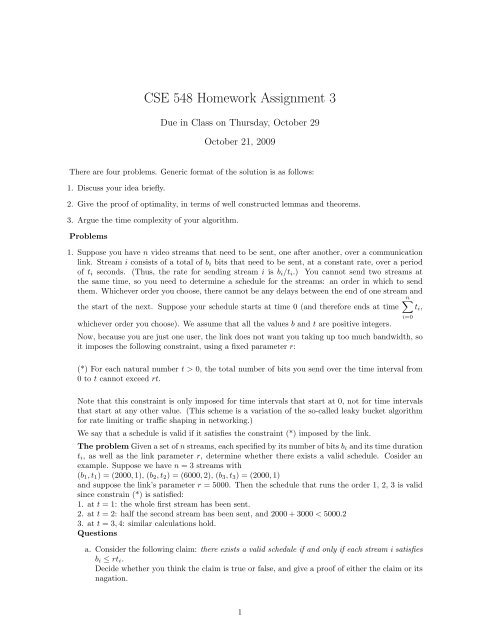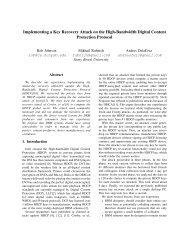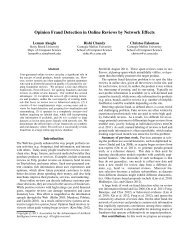CSE 548 Homework Assignment 3
CSE 548 Homework Assignment 3
CSE 548 Homework Assignment 3
Create successful ePaper yourself
Turn your PDF publications into a flip-book with our unique Google optimized e-Paper software.
<strong>CSE</strong> <strong>548</strong> <strong>Homework</strong> <strong>Assignment</strong> 3<br />
Due in Class on Thursday, October 29<br />
October 21, 2009<br />
There are four problems. Generic format of the solution is as follows:<br />
1. Discuss your idea briefly.<br />
2. Give the proof of optimality, in terms of well constructed lemmas and theorems.<br />
3. Argue the time complexity of your algorithm.<br />
Problems<br />
1. Suppose you have n video streams that need to be sent, one after another, over a communication<br />
link. Stream i consists of a total of b i bits that need to be sent, at a constant rate, over a period<br />
of t i seconds. (Thus, the rate for sending stream i is b i /t i .) You cannot send two streams at<br />
the same time, so you need to determine a schedule for the streams: an order in which to send<br />
them. Whichever order you choose, there cannot be any delays between the end of one stream and<br />
n∑<br />
the start of the next. Suppose your schedule starts at time 0 (and therefore ends at time t i ,<br />
whichever order you choose). We assume that all the values b and t are positive integers.<br />
Now, because you are just one user, the link does not want you taking up too much bandwidth, so<br />
it imposes the following constraint, using a fixed parameter r:<br />
(*) For each natural number t > 0, the total number of bits you send over the time interval from<br />
0 to t cannot exceed rt.<br />
i=0<br />
Note that this constraint is only imposed for time intervals that start at 0, not for time intervals<br />
that start at any other value. (This scheme is a variation of the so-called leaky bucket algorithm<br />
for rate limiting or traffic shaping in networking.)<br />
We say that a schedule is valid if it satisfies the constraint (*) imposed by the link.<br />
The problem Given a set of n streams, each specified by its number of bits b i and its time duration<br />
t i , as well as the link parameter r, determine whether there exists a valid schedule. Cosider an<br />
example. Suppose we have n = 3 streams with<br />
(b 1 , t 1 ) = (2000, 1), (b 2 , t 2 ) = (6000, 2), (b 3 , t 3 ) = (2000, 1)<br />
and suppose the link’s parameter r = 5000. Then the schedule that runs the order 1, 2, 3 is valid<br />
since constrain (*) is satisfied:<br />
1. at t = 1: the whole first stream has been sent.<br />
2. at t = 2: half the second stream has been sent, and 2000 + 3000 < 5000.2<br />
3. at t = 3, 4: similar calculations hold.<br />
Questions<br />
a. Consider the following claim: there exists a valid schedule if and only if each stream i satisfies<br />
b i ≤ rt i .<br />
Decide whether you think the claim is true or false, and give a proof of either the claim or its<br />
nagation.<br />
1
. Given an algorithm that takes the set of n streams, each specified by its time duration t i ,<br />
as well as the link parameter r and determines whether there exists a valid schedule. The<br />
running time of your algorithm must be a polynomial in n.<br />
2. Consider the following scheduling problem. You have a set of n computational jobs. Job i runs for<br />
time l i , and only one job can be run at a time (and cannot be preempted). Moreover, there is a set<br />
of precedence constraints on the jobs, of the form job i must be done before job j. The precedence<br />
constraints form a directed acyclic graph, such as that shown in Figure 1. Any feasible schedule<br />
must satisfy all precedence constraints.<br />
With each job i, there is associated a loss function f i (t) that measures the badness of putting off<br />
a job so that it does not complete until time t. The loss function for each job is monotonically<br />
increasing; that is, if t 1 < t 2 , then f i (t 1 ) ≤ f i (t 2 ). However, these functions are otherwise arbitrary!<br />
For example, a real-time job might be fine (zero loss) if it completes in at most t = 5 seconds but<br />
would cause a system failure (high loss) if it completes after this time. For a batch job, the loss<br />
function may increase a little bit every second, to discourage the system from putting it off too<br />
long.<br />
Your goal is to find a feasible schedule that minimizes the loss of the lossiest job. More precisely,<br />
let S be a feasible schedule, and let job i complete at time e i in S. Then the goal is to construct<br />
S so as to minimize max 1≤i≤n f i (e i ).<br />
3. As we develop sound monetization models, social networks are poised to be the next big thing.<br />
Suppose you are developing an application for a professional social network called pro-matroid.com.<br />
It provides a networking platform for professionals from various industries. With the economy<br />
poised to boom, you forsee potential in using this network to match job hunters and employers.<br />
You plan to do so by by providing an application to the employers.<br />
Prospective employees post thier resume and the employers post jobs on the network. Job seekers<br />
also post an expected renumeration.<br />
You already have an algorithm that matches applicants to jobs purely based on the skill sets and<br />
resume. After running this algorithm, you have pairings of jobs and potential matches. Remember<br />
an applicant might be a match for more than one job. Only thing remaining to be optimized is the<br />
renumeration.<br />
Now develop an algorithm that given this match, finds the cheapest pairing of jobs-applicants. The<br />
application would present this to the employers which they can add to their social network profiles.<br />
Prove the correctness of your algorithm using Matroids.<br />
4. Synchronization in distributed wireless sensor networks is a major concern. Due to topographical<br />
constraints, you have a weird routing protocol. Under this protocol, the messages start from a node<br />
and travel down a binary tree to eventually reach the leaves that represents the different sinks in<br />
the network. Nodes of this tree represent the sensor nodes acting as relays.<br />
A potential problem with having many sinks is that they will receive replicas of the information<br />
generated by the node at the root. This introduces the need of synchronization as all sinks must<br />
receive the message at the same time, for any co-ordinated response in real time.<br />
So imagine the binary tree on which the message gets routed as made up of edges having weights.<br />
Weight l e of edge e represents the delay incurred on that hop. So the total delay from the root<br />
(from where the message emanates) to a sink will be the sum of edges from the root to the sink.<br />
To ensure that the message reaches all sinks (leaves) at the same time, we must increase the weight<br />
(delay) of some of the edges. (We can not decrease the weights). This basically corresponds to<br />
buffering the packet at some intermediate nodes.<br />
The goal is to achieve synchronization in terms of packet deliver time in a way that minimizes the<br />
total delay. Devise an algorithm that achieves the goal of simultaneous delivery at all nodes with<br />
minimum total delay.<br />
2
Figure 1: sample DAG for Problem 2<br />
3















